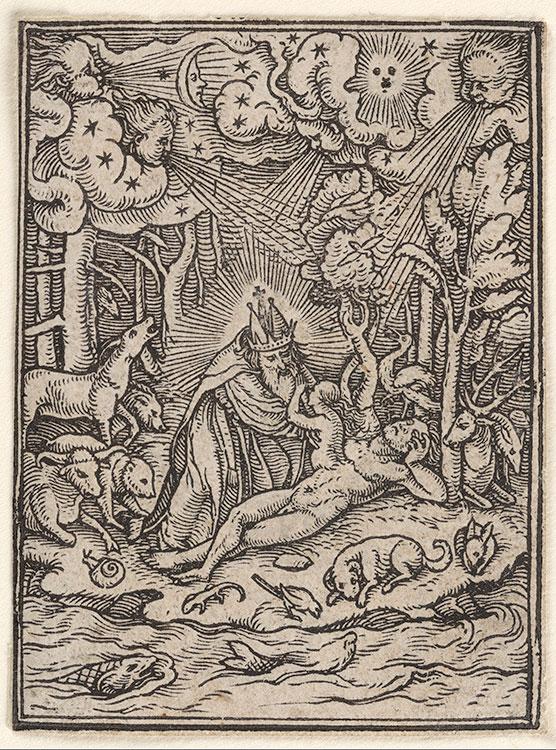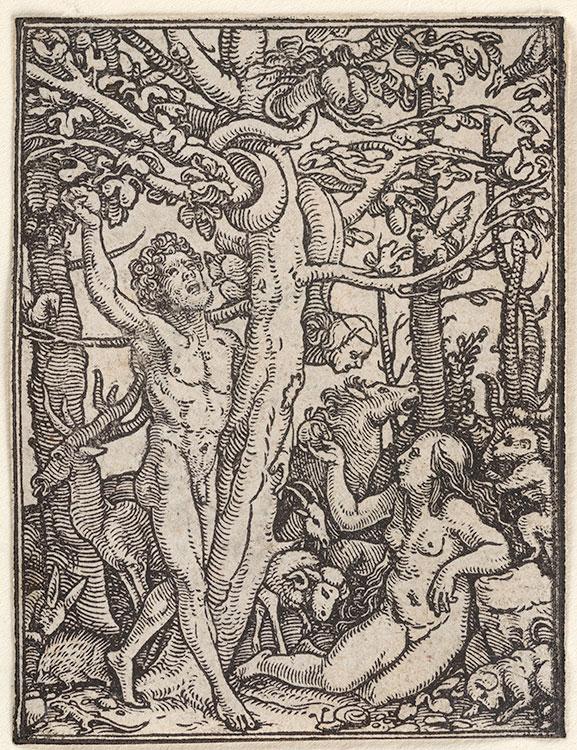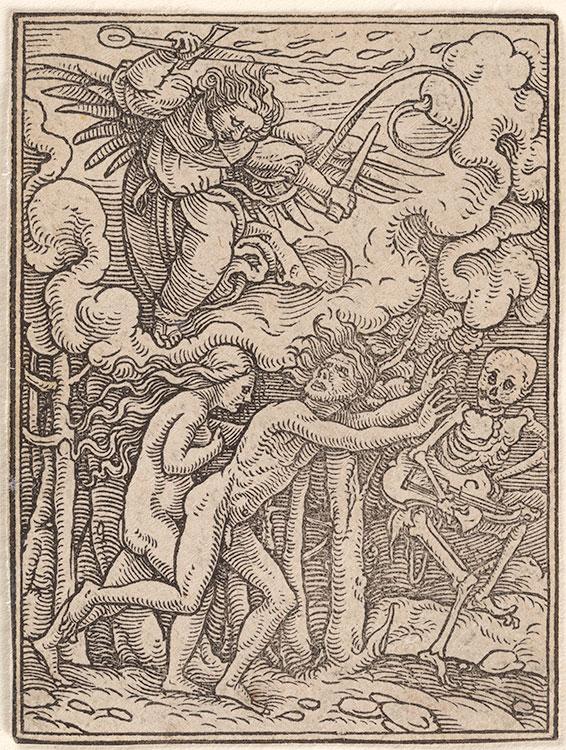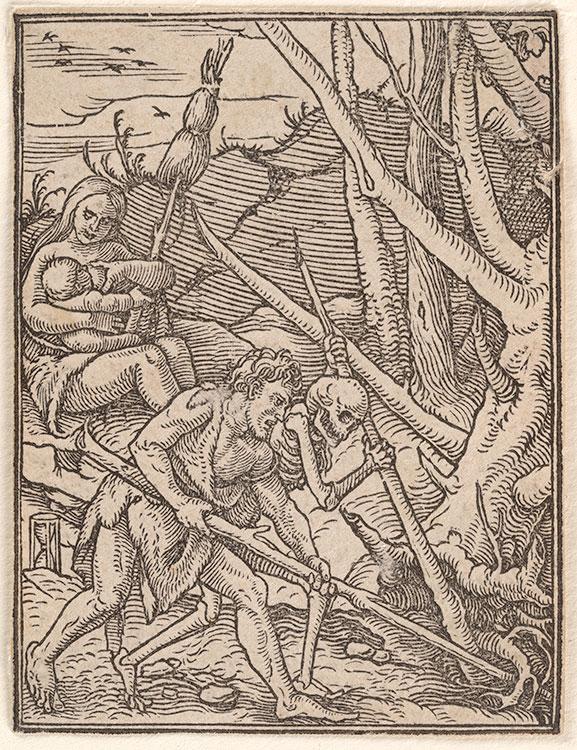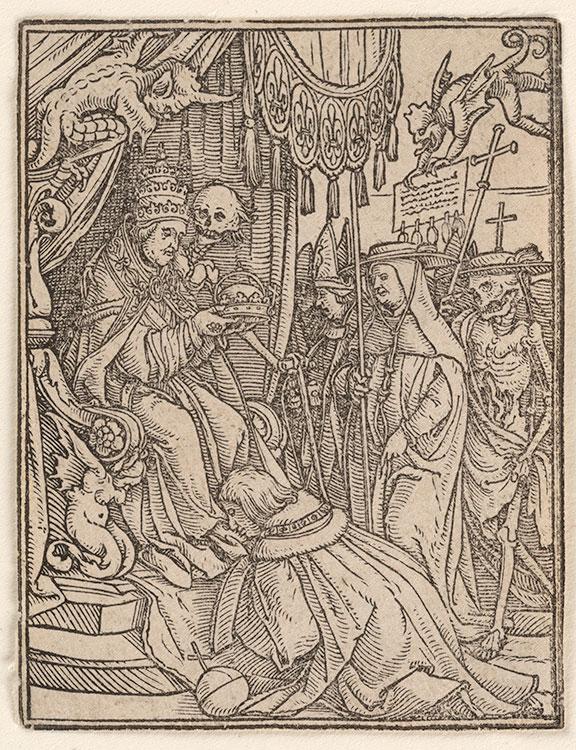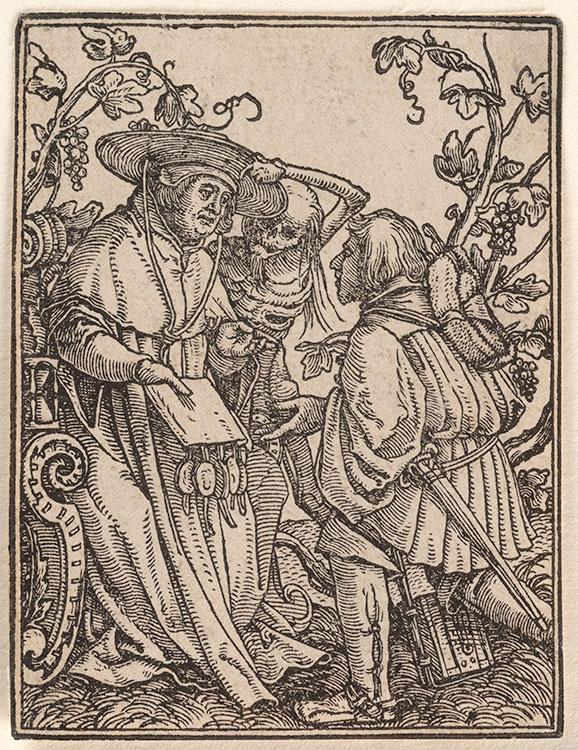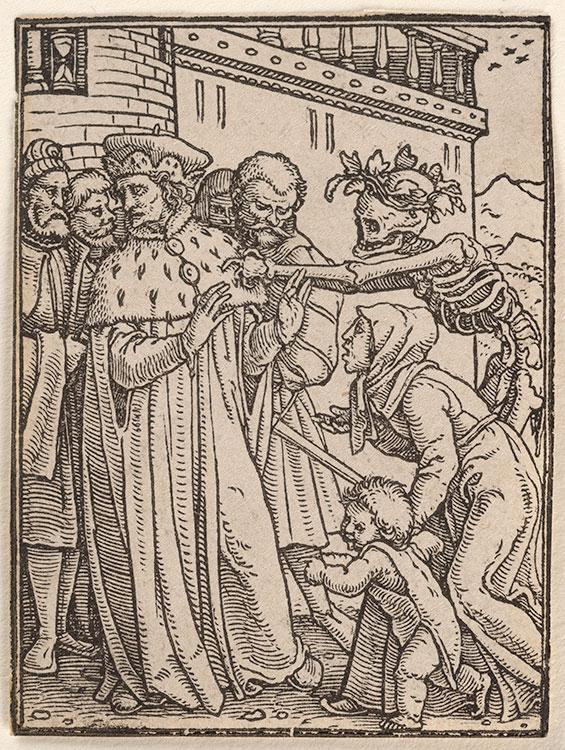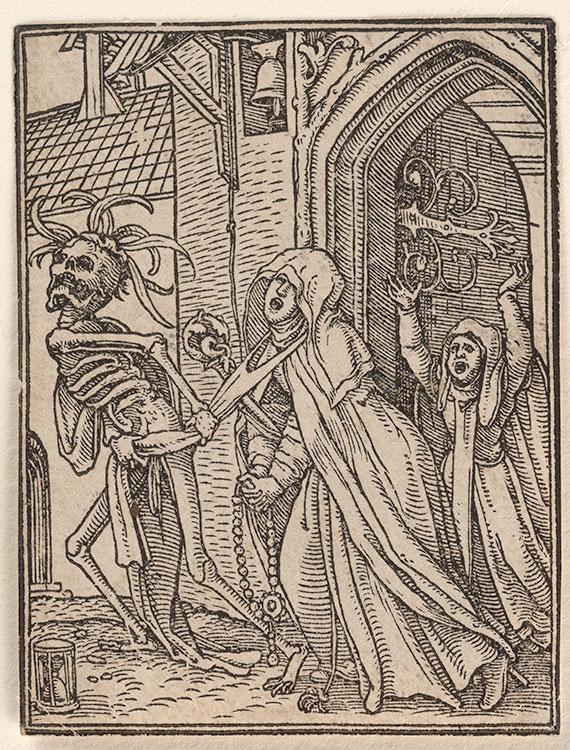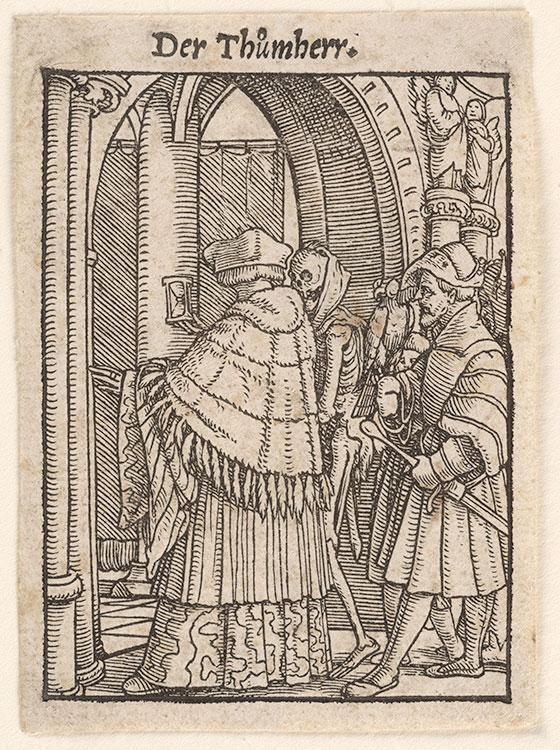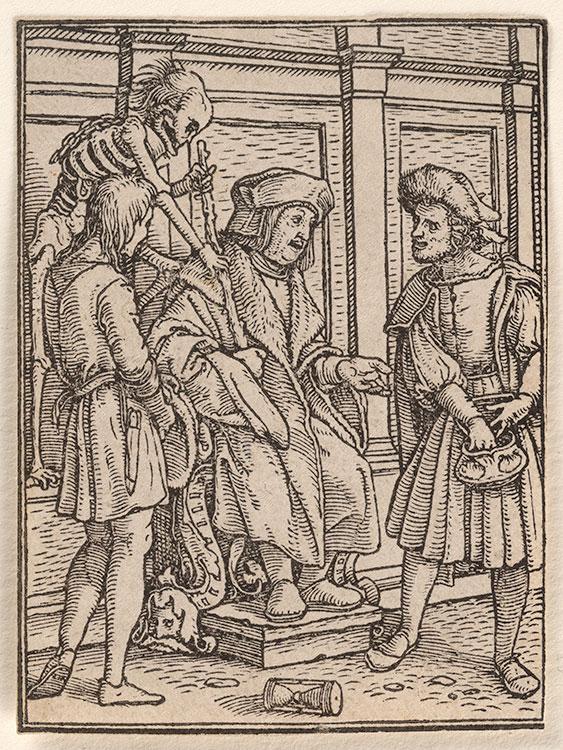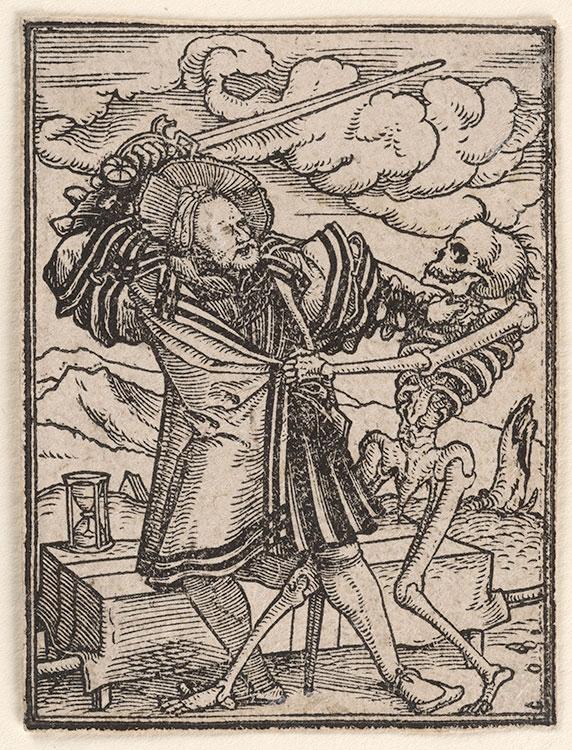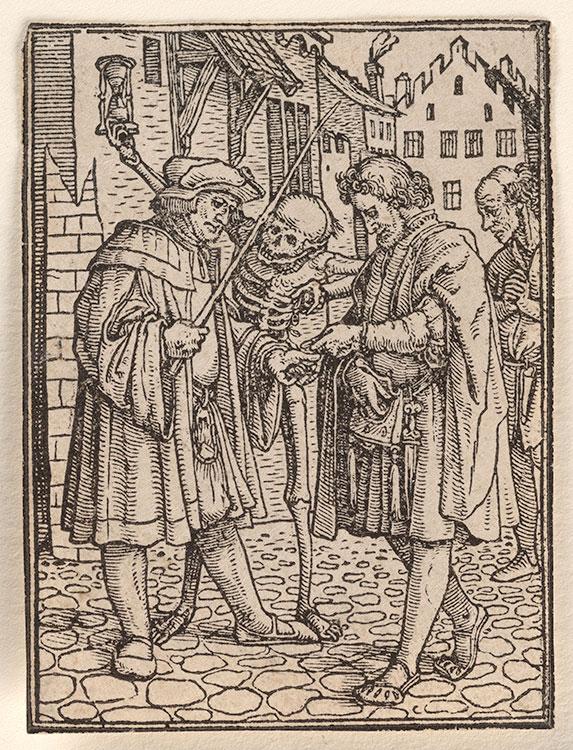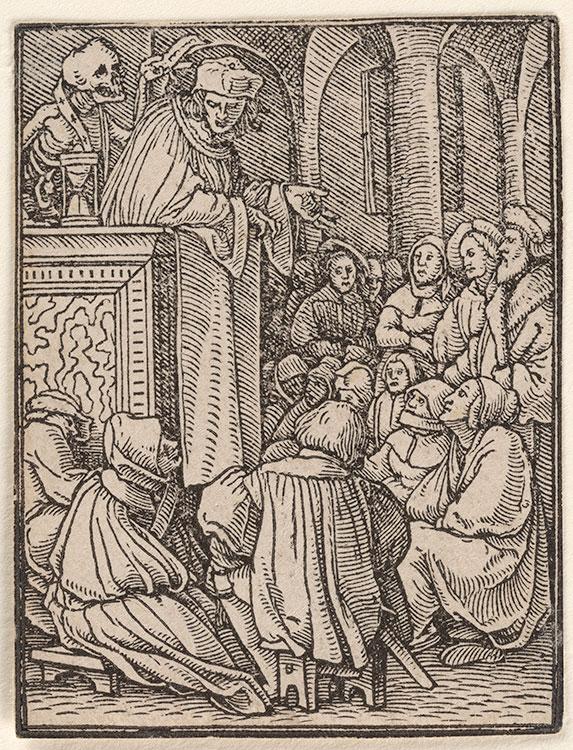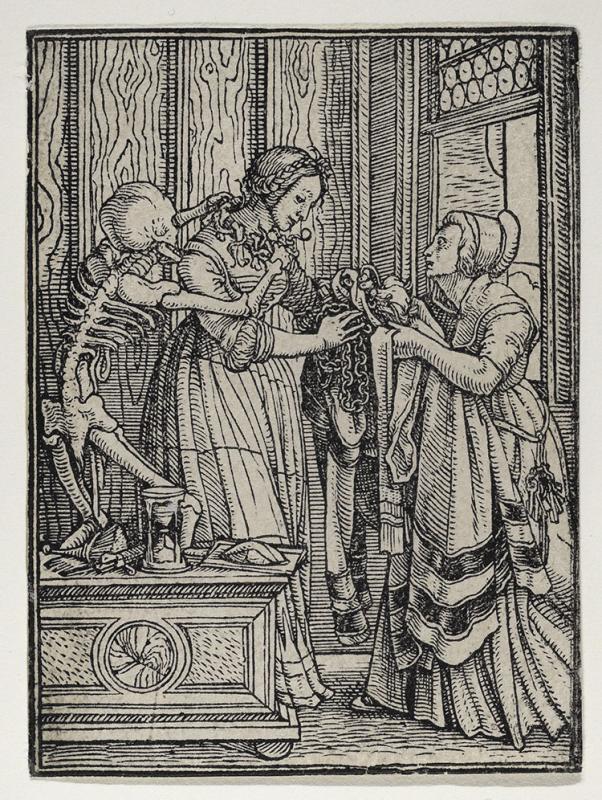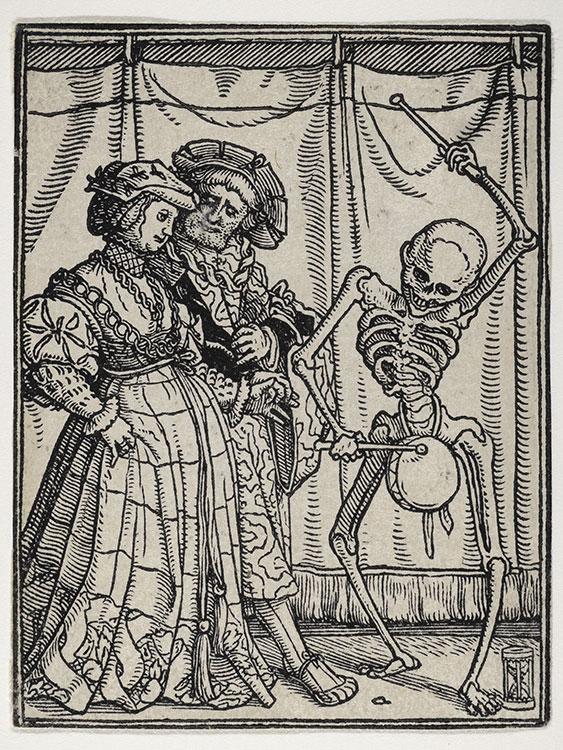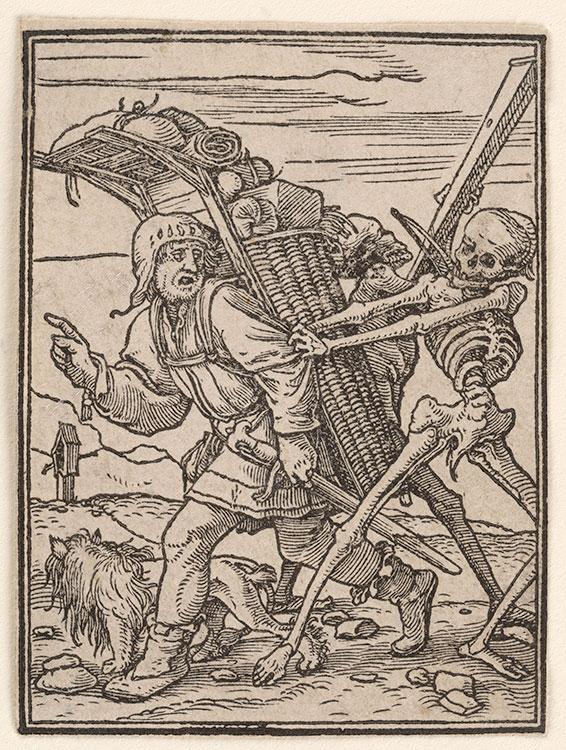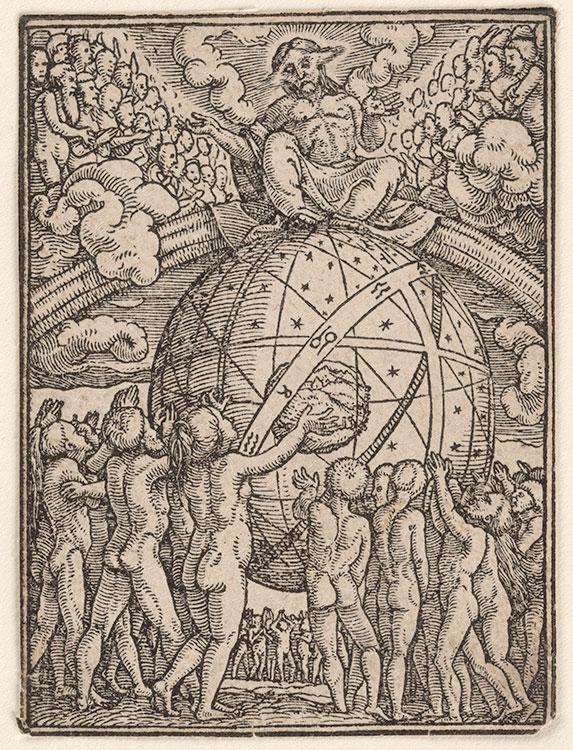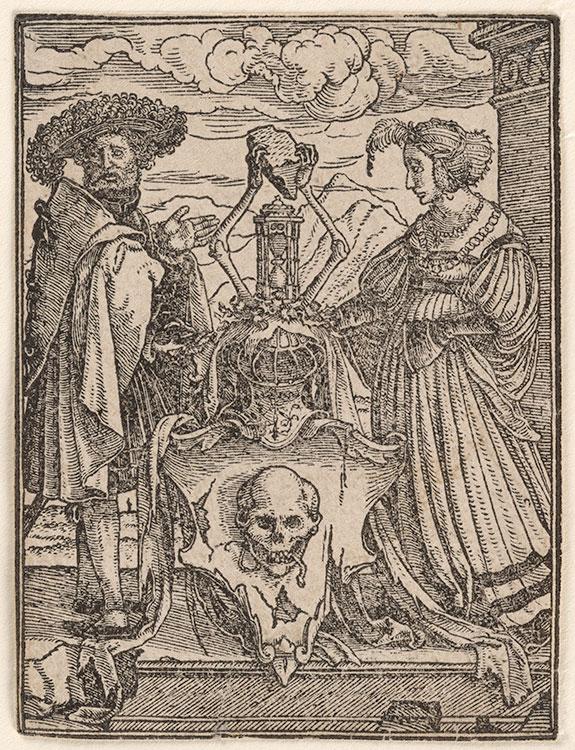Images of Death
Lützelburger and Holbein reimagined the medieval dance of death into detailed genre scenes where Death catches people amid their daily routines. As in Holbein’s portraits, objects and emblems indicate individuals’ social strata or professions and in some cases mockingly aid in their demise. Lützelburger signed the bed frame in the image of the duchess (fourth frame [far right], top row, print five) with his initials, HL. Lützelburger was an exceptionally skilled blockcutter, more so than the other artists with whom Holbein had worked, and his abilities allowed for the best translation of Holbein’s compositions into print, especially at the small scale of this series.
Hans Lützelburger (1495?–1526), after designs by Hans Holbein the Younger (1497/98–1543)
Images of Death, ca. 1526
Woodcuts
The Metropolitan Museum of Art, New York, Rogers Fund, 1919; 19.57.1–40
Contrary to what we might think today, during the Renaissance, the Dance of Death imagery was not considered morbid or scary. Rather, it served as a positive reminder to lead a good, devout life. While the earlier medieval tradition tended to represent the figures in the dance as rather unexpressive and static, Lützelburger and Holbein created a series full of action and high emotion, depicting the protagonists amid their daily routines.
Death comes into the story of humanity after the Fall, when Adam and Eve are banished from the Garden of Eden. These events are narrated in the first four scenes. The successive thirty-six prints represent Death meeting members of every social class. Holbein varied the compositions for each figure and adapted the manner in which they met their fate. Some protagonists, like the Monk or Rich Man, scream and try to fight off Death. The Sailor, Knight, and Count all meet rather violent ends. Death seems to surprise the Nun meeting with her lover and the Bishop tending his flock. The Old Man and Old Woman are more passive in the acceptance of their awaited fates. Some scholars have found Protestant sympathies in the scenes, as with the demons who help the Pope to sell indulgences—a practice famously criticized by Martin Luther in the Ninety-five Theses.
This series is the masterpiece of both Holbein’s and Lützelburger’s print careers. In each other, the two artists found a collaborator of equal talent to their respective expertise: Holbein finally had a blockcutter who could expertly translate his drawings into relief print, and Lützelburger had a draftsman whose mastery of three-dimensionality could be translated into print by his extraordinary deftness of carving.
Creation of Eve

Hans Lützelburger (1495?–1526), after designs by Hans Holbein the Younger (1497/98–1543)
Creation of Eve, ca. 1526
Woodcuts
The Metropolitan Museum of Art, New York, Rogers Fund, 1919; 19.57.1
Image copyright © The Metropolitan Museum of Art. Image source: Art Resource, NY
Fall (or Temptation of Adam)

Hans Lützelburger (1495?–1526), after designs by Hans Holbein the Younger (1497/98–1543)
Fall (or Temptation of Adam), ca. 1526
Woodcuts
The Metropolitan Museum of Art, New York, Rogers Fund, 1919; 19.57.2
Image copyright © The Metropolitan Museum of Art. Image source: Art Resource, NY
Expulsion from Paradise

Hans Lützelburger (1495?–1526), after designs by Hans Holbein the Younger (1497/98–1543)
Expulsion from Paradise, ca. 1526
Woodcuts
The Metropolitan Museum of Art, New York, Rogers Fund, 1919; 19.57.3
Image copyright © The Metropolitan Museum of Art. Image source: Art Resource, NY
Adam Plowing

Hans Lützelburger (1495?–1526), after designs by Hans Holbein the Younger (1497/98–1543)
Adam Plowing, ca. 1526
Woodcuts
The Metropolitan Museum of Art, New York, Rogers Fund, 1919; 19.57.4
Image copyright © The Metropolitan Museum of Art. Image source: Art Resource, NY
Skeletons Making Music (or the Cemetery)
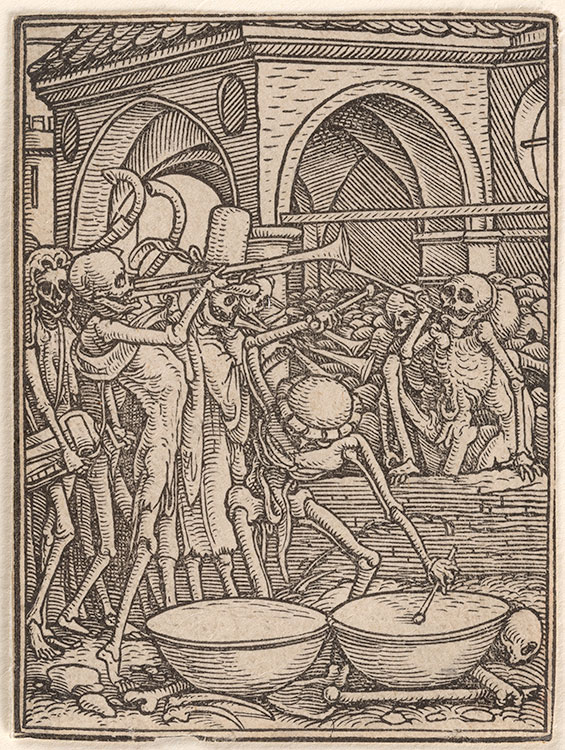
Hans Lützelburger (1495?–1526), after designs by Hans Holbein the Younger (1497/98–1543)
Skeletons Making Music (or the Cemetery), ca. 1526
Woodcuts
The Metropolitan Museum of Art, New York, Rogers Fund, 1919; 19.57.5
Death and the Pope

Hans Lützelburger (1495?–1526), after designs by Hans Holbein the Younger (1497/98–1543)
Death and the Pope, ca. 1526
Woodcuts
The Metropolitan Museum of Art, New York, Rogers Fund, 1919; 19.57.6
Image copyright © The Metropolitan Museum of Art. Image source: Art Resource, NY
Death and the Emperor
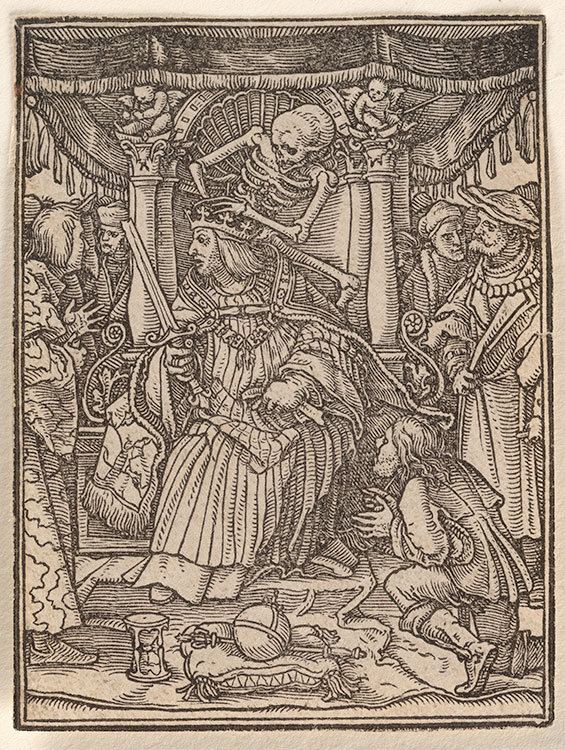
Hans Lützelburger (1495?–1526), after designs by Hans Holbein the Younger (1497/98–1543)
Death and the Emperor, ca. 1526
Woodcuts
The Metropolitan Museum of Art, New York, Rogers Fund, 1919; 19.57.7
Image copyright © The Metropolitan Museum of Art. Image source: Art Resource, NY
Death and the King
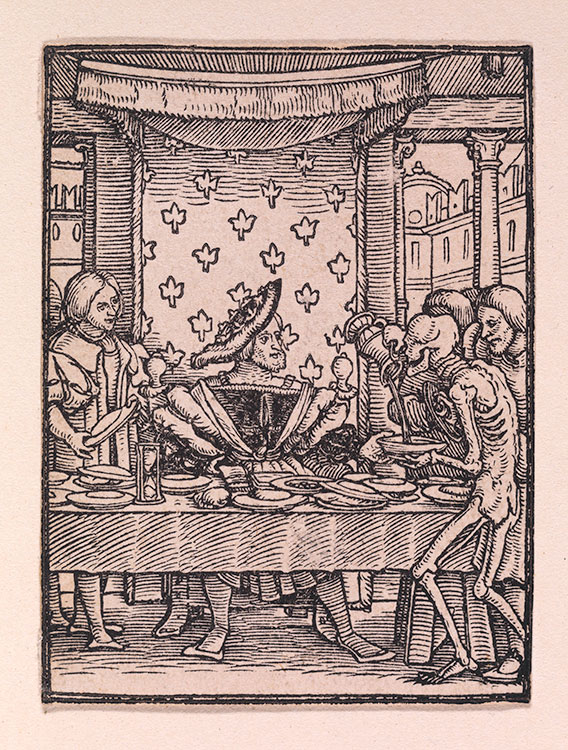
Hans Lützelburger (1495?–1526), after designs by Hans Holbein the Younger (1497/98–1543)
Death and the King, ca. 1526
Woodcuts
The Metropolitan Museum of Art, New York, Rogers Fund, 1919; 19.57.8
Image copyright © The Metropolitan Museum of Art. Image source: Art Resource, NY
Death and the Cardinal

Hans Lützelburger (1495?–1526), after designs by Hans Holbein the Younger (1497/98–1543)
Death and the Cardinal, ca. 1526
Woodcuts
The Metropolitan Museum of Art, New York, Rogers Fund, 1919; 19.57.9
Image copyright © The Metropolitan Museum of Art. Image source: Art Resource, NY
Death and the Empress

Hans Lützelburger (1495?–1526), after designs by Hans Holbein the Younger (1497/98–1543)
Death and the Empress, ca. 1526
Woodcuts
The Metropolitan Museum of Art, New York, Rogers Fund, 1919; 19.57.10
Image copyright © The Metropolitan Museum of Art. Image source: Art Resource, NY
Death and the Queen
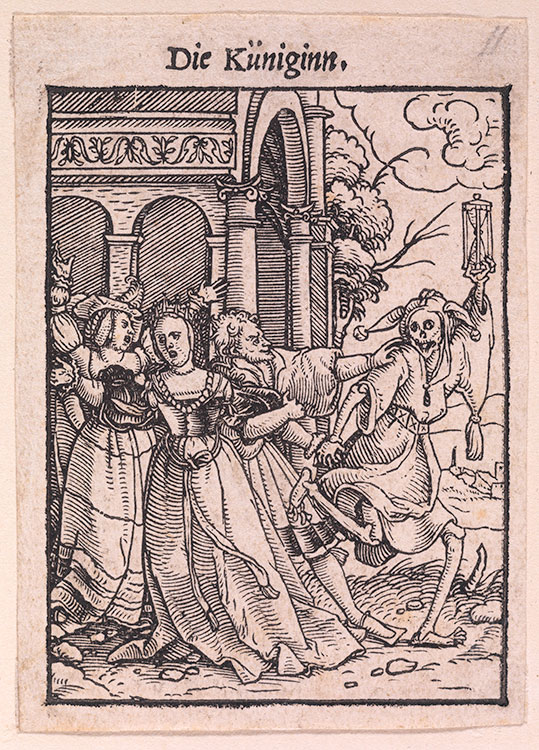
Hans Lützelburger (1495?–1526), after designs by Hans Holbein the Younger (1497/98–1543)
Death and the Queen, ca. 1526
Woodcuts
The Metropolitan Museum of Art, New York, Rogers Fund, 1919; 19.57.11
Image copyright © The Metropolitan Museum of Art. Image source: Art Resource, NY
Death and the Bishop
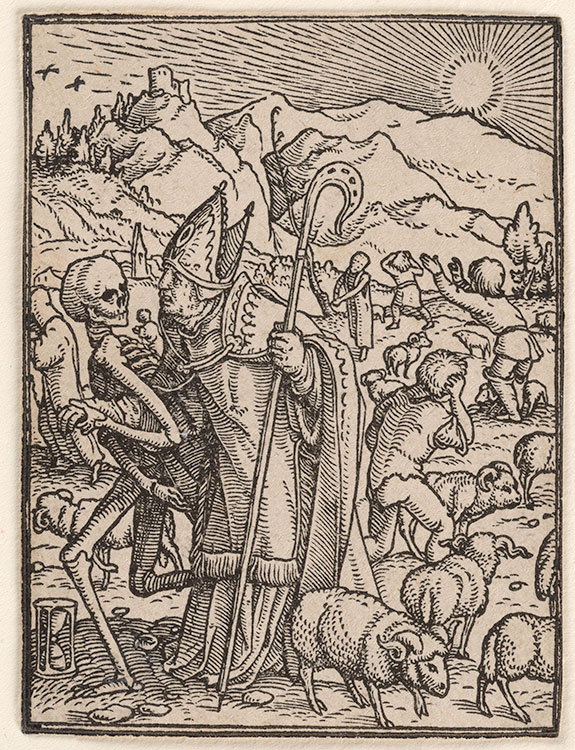
Hans Lützelburger (1495?–1526), after designs by Hans Holbein the Younger (1497/98–1543)
Death and the Bishop, ca. 1526
Woodcuts
The Metropolitan Museum of Art, New York, Rogers Fund, 1919; 19.57.12
Image copyright © The Metropolitan Museum of Art. Image source: Art Resource, NY
Death and the Duke

Hans Lützelburger (1495?–1526), after designs by Hans Holbein the Younger (1497/98–1543)
Death and the Duke, ca. 1526
Woodcuts
The Metropolitan Museum of Art, New York, Rogers Fund, 1919; 19.57.13
Image copyright © The Metropolitan Museum of Art. Image source: Art Resource, NY
Death and the Abbot

Hans Lützelburger (1495?–1526), after designs by Hans Holbein the Younger (1497/98–1543)
Death and the Abbot, ca. 1526
Woodcuts
The Metropolitan Museum of Art, New York, Rogers Fund, 1919; 19.57.14
Image copyright © The Metropolitan Museum of Art. Image source: Art Resource, NY
Death and the Abbess

Hans Lützelburger (1495?–1526), after designs by Hans Holbein the Younger (1497/98–1543)
Death and the Abbess, ca. 1526
Woodcuts
The Metropolitan Museum of Art, New York, Rogers Fund, 1919; 19.57.15
Image copyright © The Metropolitan Museum of Art. Image source: Art Resource, NY
Death and the Dean (or Canon)
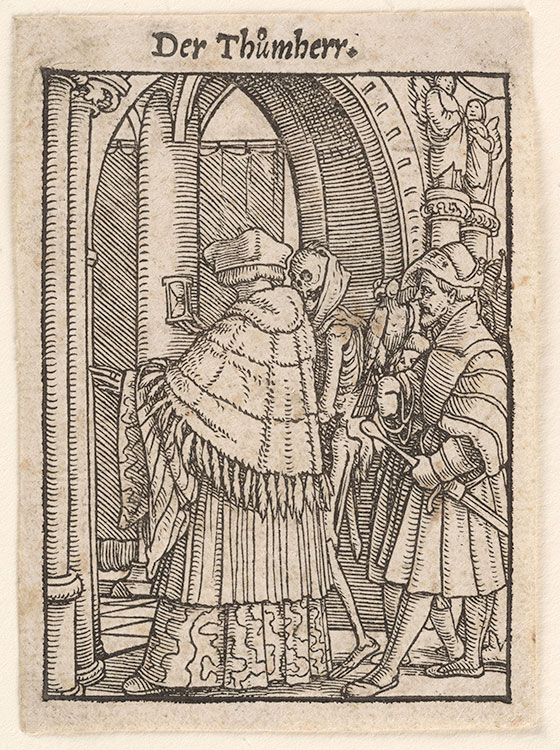
Hans Lützelburger (1495?–1526), after designs by Hans Holbein the Younger (1497/98–1543)
Death and the Dean (or Canon), ca. 1526
Woodcuts
The Metropolitan Museum of Art, New York, Rogers Fund, 1919; 19.57.16
Image copyright © The Metropolitan Museum of Art. Image source: Art Resource, NY
Death and the Judge

Hans Lützelburger (1495?–1526), after designs by Hans Holbein the Younger (1497/98–1543)
Death and the Judge, ca. 1526
Woodcuts
The Metropolitan Museum of Art, New York, Rogers Fund, 1919; 19.57.1–40
Image copyright © The Metropolitan Museum of Art. Image source: Art Resource, NY
Death and the Nobleman
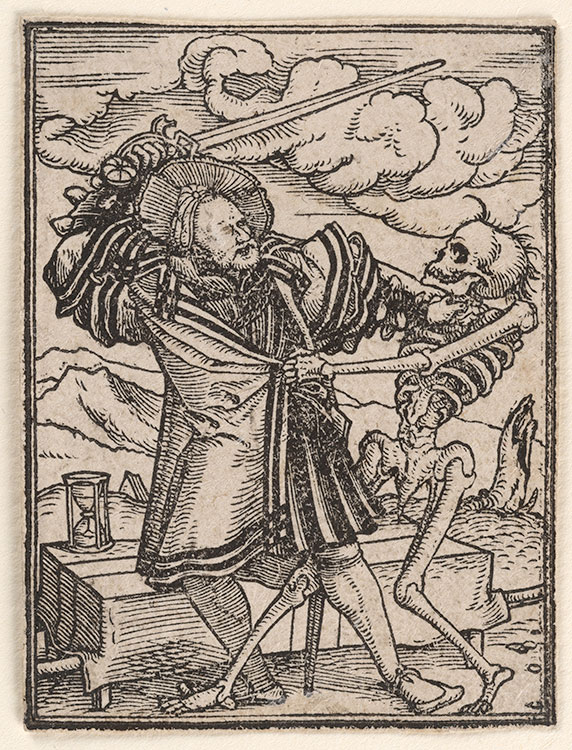
Hans Lützelburger (1495?–1526), after designs by Hans Holbein the Younger (1497/98–1543)
Death and the Nobleman, ca. 1526
Woodcuts
The Metropolitan Museum of Art, New York, Rogers Fund, 1919; 19.57.18
Image copyright © The Metropolitan Museum of Art. Image source: Art Resource, NY
Death and the Lawyer (or Advocate)
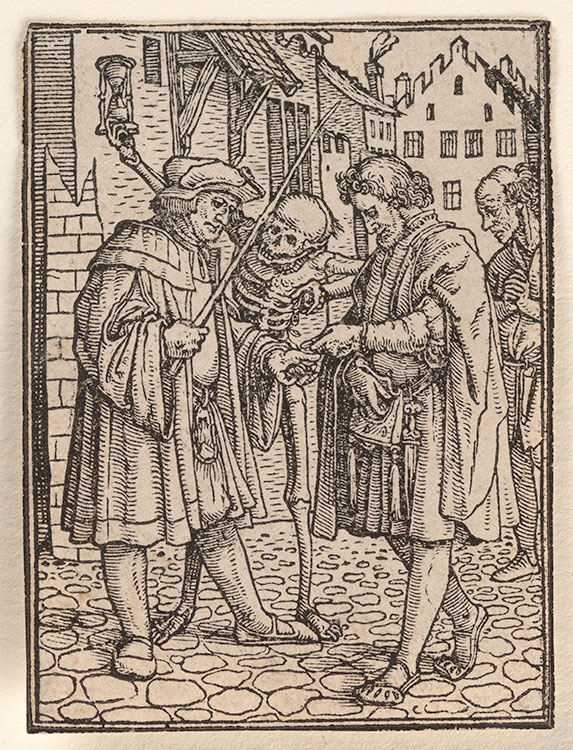
Hans Lützelburger (1495?–1526), after designs by Hans Holbein the Younger (1497/98–1543)
Death and the Lawyer (or Advocate), ca. 1526
Woodcuts
The Metropolitan Museum of Art, New York, Rogers Fund, 1919; 19.57.19
Image copyright © The Metropolitan Museum of Art. Image source: Art Resource, NY
Death and the Councilor

Hans Lützelburger (1495?–1526), after designs by Hans Holbein the Younger (1497/98–1543)
Death and the Councilor, ca. 1526
Woodcuts
The Metropolitan Museum of Art, New York, Rogers Fund, 1919; 19.57.20
Image copyright © The Metropolitan Museum of Art. Image source: Art Resource, NY
Death and the Clergyman

Hans Lützelburger (1495?–1526), after designs by Hans Holbein the Younger (1497/98–1543)
Death and the Clergyman, ca. 1526
Woodcuts
The Metropolitan Museum of Art, New York, Rogers Fund, 1919; 19.57.21
Image copyright © The Metropolitan Museum of Art. Image source: Art Resource, NY
Death and the Priest (or Preacher)
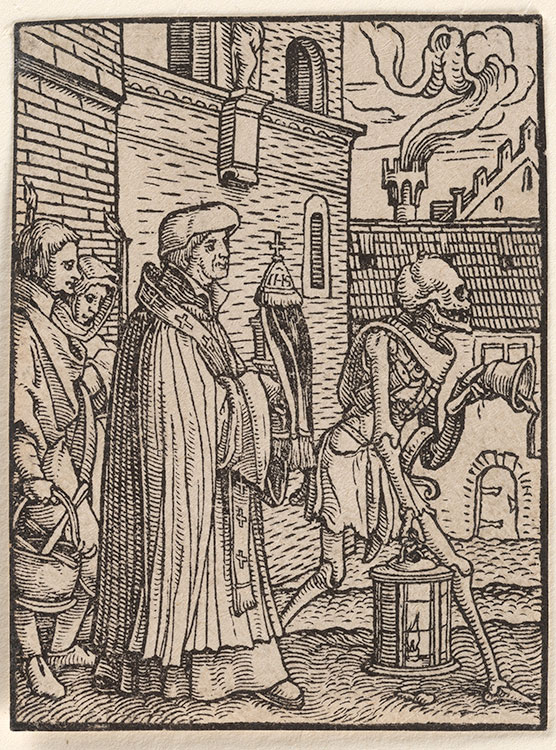
Hans Lützelburger (1495?–1526), after designs by Hans Holbein the Younger (1497/98–1543)
Death and the Priest (or Preacher), ca. 1526
Woodcuts
The Metropolitan Museum of Art, New York, Rogers Fund, 1919; 19.57.22
Image copyright © The Metropolitan Museum of Art. Image source: Art Resource, NY
Death and the Monk (or Mendicant)

Hans Lützelburger (1495?–1526), after designs by Hans Holbein the Younger (1497/98–1543)
Death and the Monk (or Mendicant), ca. 1526
Woodcuts
The Metropolitan Museum of Art, New York, Rogers Fund, 1919; 19.57.23
Image copyright © The Metropolitan Museum of Art. Image source: Art Resource, NY
Death and the Nun

Hans Lützelburger (1495?–1526), after designs by Hans Holbein the Younger (1497/98–1543)
Death and the Nun, ca. 1526
Woodcuts
The Metropolitan Museum of Art, New York, Rogers Fund, 1919; 19.57.24
Image copyright © The Metropolitan Museum of Art. Image source: Art Resource, NY
Death and the Old Woman
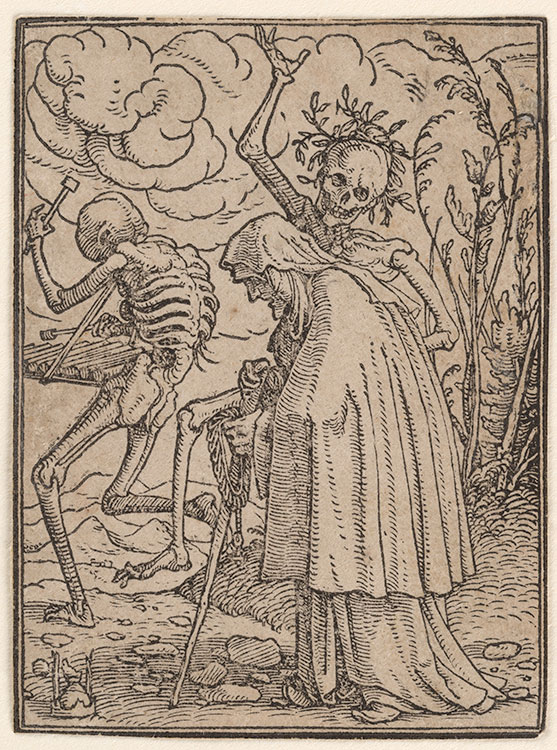
Hans Lützelburger (1495?–1526), after designs by Hans Holbein the Younger (1497/98–1543)
Death and the Old Woman, ca. 1526
Woodcuts
The Metropolitan Museum of Art, New York, Rogers Fund, 1919; 19.57.25
Image copyright © The Metropolitan Museum of Art. Image source: Art Resource, NY
Death and the Doctor (or Physician)
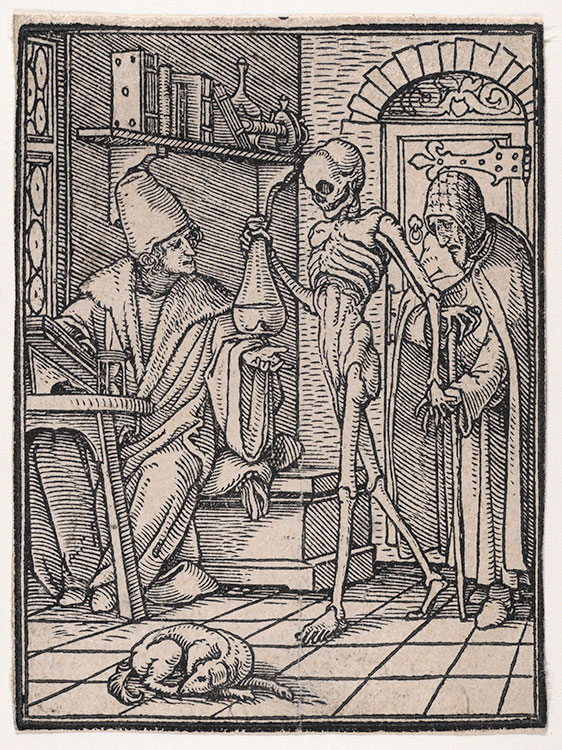
Hans Lützelburger (1495?–1526), after designs by Hans Holbein the Younger (1497/98–1543)
Death and the Doctor (or Physician), ca. 1526
Woodcuts
The Metropolitan Museum of Art, New York, Rogers Fund, 1919; 19.57.26
Image copyright © The Metropolitan Museum of Art. Image source: Art Resource, NY
Death and the Rich Man

Hans Lützelburger (1495?–1526), after designs by Hans Holbein the Younger (1497/98–1543)
Death and the Rich Man, ca. 1526
Woodcuts
The Metropolitan Museum of Art, New York, Rogers Fund, 1919; 19.57.27
Image copyright © The Metropolitan Museum of Art. Image source: Art Resource, NY
Death and the Merchant

Hans Lützelburger (1495?–1526), after designs by Hans Holbein the Younger (1497/98–1543)
Death and the Merchant, ca. 1526
Woodcuts
The Metropolitan Museum of Art, New York, Rogers Fund, 1919; 19.57.28
Image copyright © The Metropolitan Museum of Art. Image source: Art Resource, NY
Death and the Skipper (or Sailor)

Hans Lützelburger (1495?–1526), after designs by Hans Holbein the Younger (1497/98–1543)
Death and the Skipper (or Sailor), ca. 1526
Woodcuts
The Metropolitan Museum of Art, New York, Rogers Fund, 1919; 19.57.29
Image copyright © The Metropolitan Museum of Art. Image source: Art Resource, NY
Coat of Arms of Death

Hans Lützelburger (1495?–1526), after designs by Hans Holbein the Younger (1497/98–1543)
Coat of Arms of Death, ca. 1526
Woodcuts
The Metropolitan Museum of Art, New York, Rogers Fund, 1919; 19.57.40
Image copyright © The Metropolitan Museum of Art. Image source: Art Resource, NY
Death and the Child
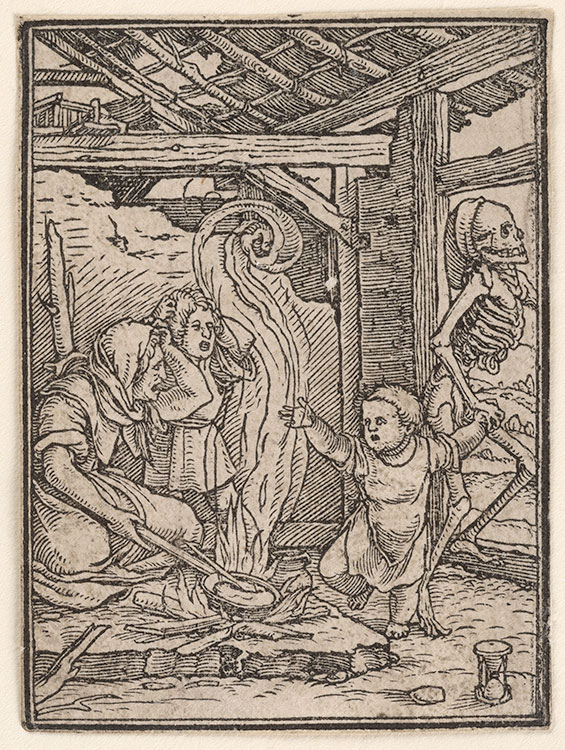
Hans Lützelburger (1495?–1526), after designs by Hans Holbein the Younger (1497/98–1543)
Death and the Child, ca. 1526
Woodcuts
The Metropolitan Museum of Art, New York, Rogers Fund, 1919; 19.57.38
Image copyright © The Metropolitan Museum of Art. Image source: Art Resource, NY
Death and the Count
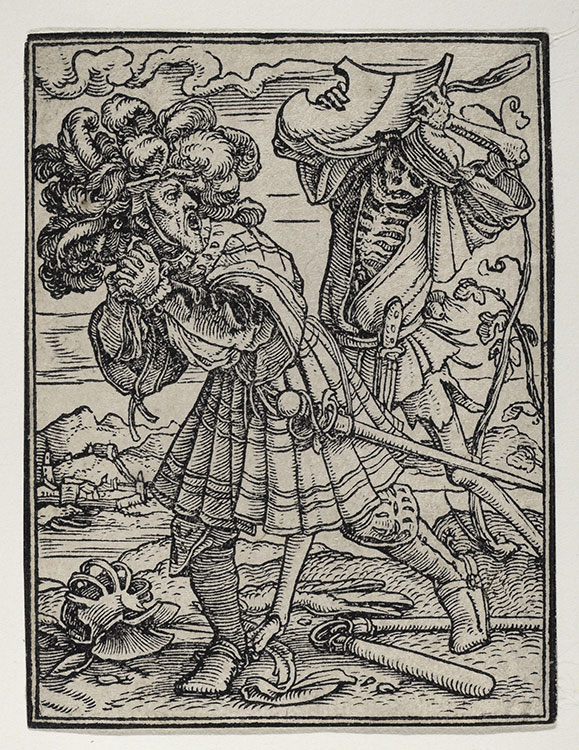
Hans Lützelburger (1495?–1526), after designs by Hans Holbein the Younger (1497/98–1543)
Death and the Count, ca. 1526
Woodcuts
The Metropolitan Museum of Art, New York, Rogers Fund, 1919; 19.57.31
Image copyright © The Metropolitan Museum of Art. Image source: Art Resource, NY
Death and the Countess

Hans Lützelburger (1495?–1526), after designs by Hans Holbein the Younger (1497/98–1543)
Death and the Countess, ca. 1526
Woodcuts
The Metropolitan Museum of Art, New York, Rogers Fund, 1919; 19.57.33
Image copyright © The Metropolitan Museum of Art. Image source: Art Resource, NY
Death and the Duchess

Hans Lützelburger (1495?–1526), after designs by Hans Holbein the Younger (1497/98–1543)
Death and the Duchess, ca. 1526
Woodcuts
The Metropolitan Museum of Art, New York, Rogers Fund, 1919; 19.57.35
Image copyright © The Metropolitan Museum of Art. Image source: Art Resource, NY
Death and the Knight

Hans Lützelburger (1495?–1526), after designs by Hans Holbein the Younger (1497/98–1543)
Death and the Knight, ca. 1526
Woodcuts
The Metropolitan Museum of Art, New York, Rogers Fund, 1919; 19.57.30
Image copyright © The Metropolitan Museum of Art. Image source: Art Resource, NY
Death and the Noblewoman

Hans Lützelburger (1495?–1526), after designs by Hans Holbein the Younger (1497/98–1543)
Death and the Noblewoman, ca. 1526
Woodcuts
The Metropolitan Museum of Art, New York, Rogers Fund, 1919; 19.57.34
Image copyright © The Metropolitan Museum of Art. Image source: Art Resource, NY
Death and the Old Man

Hans Lützelburger (1495?–1526), after designs by Hans Holbein the Younger (1497/98–1543)
Death and the Old Man, ca. 1526
Woodcuts
The Metropolitan Museum of Art, New York, Rogers Fund, 1919; 19.57.32
Image copyright © The Metropolitan Museum of Art. Image source: Art Resource, NY
Death and the Plowman (or Peasant)
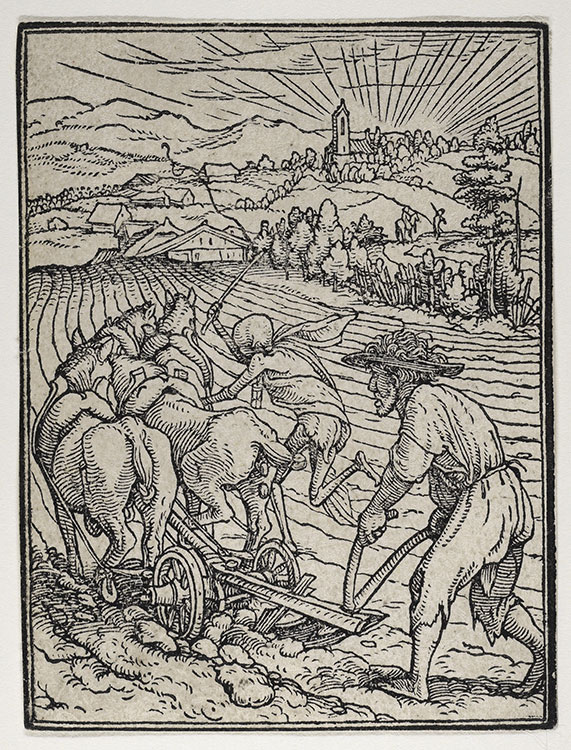
Hans Lützelburger (1495?–1526), after designs by Hans Holbein the Younger (1497/98–1543)
Death and the Plowman (or Peasant), ca. 1526
Woodcuts
The Metropolitan Museum of Art, New York, Rogers Fund, 1919; 19.57.37
Image copyright © The Metropolitan Museum of Art. Image source: Art Resource, NY
Death and the Shopkeeper (or Trader)

Hans Lützelburger (1495?–1526), after designs by Hans Holbein the Younger (1497/98–1543)
Death and the Shopkeeper (or Trader), ca. 1526
Woodcuts
The Metropolitan Museum of Art, New York, Rogers Fund, 1919; 19.57.36
Image copyright © The Metropolitan Museum of Art. Image source: Art Resource, NY
The Last Judgment

Hans Lützelburger (1495?–1526), after designs by Hans Holbein the Younger (1497/98–1543)
The Last Judgment, ca. 1526
Woodcuts
The Metropolitan Museum of Art, New York, Rogers Fund, 1919; 19.57.39
Image copyright © The Metropolitan Museum of Art. Image source: Art Resource, NY
